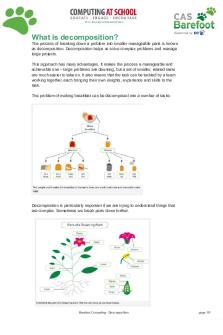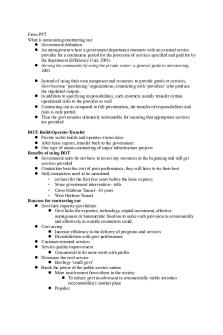Chapter 3 What Is Money PDF

| Title | Chapter 3 What Is Money |
|---|---|
| Author | Sócrates Álvarez |
| Course | Money Banking & Government Policy |
| Institution | McGill University |
| Pages | 4 |
| File Size | 180.5 KB |
| File Type | |
| Total Downloads | 29 |
| Total Views | 911 |
Summary
Chapter 3: What Is Money? Book notes Meaning of money Economists define money as anything that is generally accepted in payment for goods or services or in the repayment of debts. However, in theory, there is no single, precise definition of money or the money supply, even for economists. Currency N...
Description
Chapter 3: What Is Money? Book notes Meaning of money ● Economists define money as anything that is generally accepted in payment for goods or services or in the repayment of debts. ○ However, in theory, there is no single, precise definition of money or the money supply, even for economists. ● Currency NOT = money!!! Currency is paper money and coins. ● Money vs. wealth ○ Money is used to make purchases. ○ Wealth, in the other hand, is the total collection of pieces of property that serve to store value. Wealth includes not only money but also other assets such as bonds, common stock, art, land, furniture, cars and houses. ● What about income? What is it? ○ Income is flow of earnings per unit of time. Functions of Money ● Money has three primary functions in any economy: as medium of exchange, as a unit of account, and as a store of value. ● (1) Medium of exchange ○ If we didn’t have money as a medium of exchange we would live in a barter economy. This is inefficient and costly. Why? i. In a barter economy, people would have to satisfy a “double coincide of wants”, meaning they have to find someone who has a good or service they want and who also wants the good or service they have to offer. ii. Finding such person would be difficult and time-consuming, which means high transactions costs- the time spent trying to exchange good or services. iii. Such high transaction costs might force some people to change to labours to one that they are not as good. (*) This was explained in the book by the example of an economics professor in a barter economy. Only thing she was good at was giving amazing lectures. In a barter economy, for her to find food, she would have to find a farmer that grows the type of food she likes and is also interested in taking econ class(double coincidence of wants). This search as you would imagine would be very difficult and timeconsuming(transaction costs). Such high transactions cost might force the professor to switch her careers to farmer before she starves to death. The economy is worse off, as she is better at being a professor. ○ Money eliminates all these problems by eliminating much of the time spent exchanging goods, a.k.a it reduces transactions costs. ○ For a commodity to function effectively as money, its has meet several criterias: i. It must be easily standardized, make it simple to ascertain its value ii. It must be widely accepted(a.k.a universally accepted) iii. It must be divisible so that it is easy to “make change”. iv. It must be east to carry v. It must not deteriorate. ● (2) Unit of account ○ The second role of money is to provide a unit of account; that is, it used to measure value in the economy. ○
In a barter economy we need
N (N−1) 2
prices where N is the total number of goods in
the economy. So in a 100 good barter economy, we would need 4950 prices!!
○
●
This tremendous amount of prices represents a big transaction cost for customers. Every product would have a list of different prices and you would have to go through all of them just to see which one is better for you. ○ In an economy with money you only need 1000 prices for 1000 products, and so on. As everything is expressed in a unit of account. ○ That said, using money as a unit of account reduces transaction costs in an economy by reducing the number of prices that need to be considered. (3) Store of value ○ The third function of money is as store of value; it is a repository of purchasing power over time. ○ Money is NOT unique as a store of value; any asset, whether money, stocks, bonds, houses, art or jewellery can be used to store wealth. And most of them have an advantage over money as a store of value: they often pay the owner a higher interest rate than money, experience appreciation and deliver services! So if these assets are more desirable store of value than money, why do people hold money at all? i. BECAUSE LIQUIDITY-the relative ease and speed with which an asset can be converted into a medium of exchange. ii. Money is the most liquid asset of all because IT IS the medium of exchange, there’s no conversion to be made. iii. As you might imagine liquidity is highly desirable, you want to be able to pay your bills immediately, you don’t want to wait to purchase what you want. This explains why people hold money even if it’s not the most attractive store of value. ○ How good a store of value money is depends on the price level, because its value is fixed in terms of the price level. i. All prices double → value of money drops by half ii. All prices halved → value of money doubles ○ Hyperinflation: Inflation rate exceeds 50% per month. i. No one wants to hold money → ii. Barter becomes more dominant → iii. Output in the economy falls sharply
Evolution of the payment systems ● First, what is a payment system? Is the method of conducting transactions in the economy. ● (1) Commodity Money ○ What is it? Money made up of precious metals or another valuable commodity. ○ Why did we use it? For any object to function as money, it must be universally accepted. Precious metals clearly have value to everyone which make its a good candidate for money. ○ Problem with it? Commodity money is very heavy and is hard to transport ● (2) Fiat money ○ What is it? Paper currency decreed by governments as legal tender(legally it must be accepted as payment for debts) but not convertible into coins or precious metals, like in the past. ○ Why do we use it? They are much lighter than coins and metals and they are accepted as a medium of exchange. i. However, for it to be accepted as medium of exchange, there must some trust in the authorities who issue it ii. And printing must have reached a sufficiently advanced stage that counterfeiting is extremely difficult. ○ Problems with it? They are easily stolen and can be expensive to transport because of their bulk if there are large amounts. ● (3) Cheques ○ What is it? Is an instrument from you to your bank used to transfer money from your account to someone else’s account when she deposits the cheque.
○
●
●
Why do we use it? i. Easy to carry. Cheques allow transactions to take place without the need to carry around large amounts of currency. ii. Reduces transportation costs and improve economic efficiency. It improves the efficiency of payment systems as with cheques payments made back and forth cancel each other, without them, this would involve the movement of a lot currency. iii. Reduces loss from theft and they provide convenient receipt for purchases. iv. They can be written for any amount up to the balance in the account, this making transactions for large amounts much easier. ○ Problems with it? i. It takes too much time. It takes time to get one cheque from one place to another and it takes several business days before a bank will allow you to make use of the funds from the cheque. ii. All the paper shuffling required to process cheques is costly. (4) Electronic payment ○ What is it? Not really explained ○ Why do we use it? It’s cheaper than cheques to process. Estimated cost saving when a bill is paid electronically rather than by cheque exceed one dollar. ○ Problems with it? Not really explained. (5) E-Money ○ What is it? Money that exists only in the electronic form. i. Debit cards, smart cards ii. E-cash not really explained what it is ○ Why do we use it? ○ Problems with it?
Measuring Money ● Money is defined by people’s behaviour. This is a loose definition which is not optimal when measuring. In change, we need precise definitions. ● Float: funds in transit between the time a cheque is deposited and the time the payment is settled. ● The Bank of Canada settled settled on the following measures of money supply or money aggregates.
●
We cannot be sure which of the money aggregate is the true measure of money, thus it is desirable
● ● ●
to think they move together because if they do no matter what measure you use to predict future performance you are going to get the same result. In fact, M2, M1++ and M2++ growth rate rates tend to move together. However there are exceptions. Money as weighted aggregate ○ No entiendo por ahora How reliable are the money data? ○ “We probably should not pay much attention to short-run movement in the money supply numbers but should be concerned only with longer-run movements”...
Similar Free PDFs

Chapter 3 What Is Money
- 4 Pages

Chapter 9 What is Deviance
- 5 Pages

Chapter 1 What Is Psychology
- 42 Pages

Chapter 2 What is Phonetics
- 6 Pages

1-3 Short Answer What is History
- 2 Pages

What is cost accounting
- 17 Pages

What is Simulated Annealing
- 5 Pages

What is grammar?
- 1 Pages
Popular Institutions
- Tinajero National High School - Annex
- Politeknik Caltex Riau
- Yokohama City University
- SGT University
- University of Al-Qadisiyah
- Divine Word College of Vigan
- Techniek College Rotterdam
- Universidade de Santiago
- Universiti Teknologi MARA Cawangan Johor Kampus Pasir Gudang
- Poltekkes Kemenkes Yogyakarta
- Baguio City National High School
- Colegio san marcos
- preparatoria uno
- Centro de Bachillerato Tecnológico Industrial y de Servicios No. 107
- Dalian Maritime University
- Quang Trung Secondary School
- Colegio Tecnológico en Informática
- Corporación Regional de Educación Superior
- Grupo CEDVA
- Dar Al Uloom University
- Centro de Estudios Preuniversitarios de la Universidad Nacional de Ingeniería
- 上智大学
- Aakash International School, Nuna Majara
- San Felipe Neri Catholic School
- Kang Chiao International School - New Taipei City
- Misamis Occidental National High School
- Institución Educativa Escuela Normal Juan Ladrilleros
- Kolehiyo ng Pantukan
- Batanes State College
- Instituto Continental
- Sekolah Menengah Kejuruan Kesehatan Kaltara (Tarakan)
- Colegio de La Inmaculada Concepcion - Cebu







